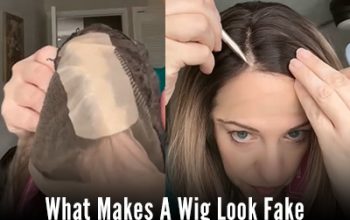Overview:
Styling real hair wigs involves putting extra layers to give the wig minimal movement, volume and also a natural look. This involves trimming and styling of the wig in a different manner that is more appealing to the eyes. In this tutorial, the various procedures and precautions that need to be followed when applying layers on real hair wigs for women will be explained to make sure that the wig does not get spoiled during the process.
Introduction:
Real hair wigs are also preferred by women who would like to have wigs that are natural looking as well as flexible. While synthetic wigs can only be styled with extra caution, real hair wigs can be styled in any way you want, including adding layers. No matter whether you desire a small alteration or an extreme makeover, layering differs the look to a large extent, and helps to get a better product that will correspond to the style one prefers.
However, cutting and layering a wig requires skill and precision. It does not refer to the mere trimming here and there; it refers to the knowledge of how the hair falls and the trimming should fit your face shape and the initial style of the wig. In this blog, let me explain the systematic process of adding layers to real hair wigs for women so that it augments the beauty and appearance of the wig and doesn’t harm the hair quality.
How to Add Layers to Real Hair Wigs for Women
1. Understanding the Basics of Layering
Before diving into the actual cutting process, it’s essential to understand what layering entails. Layers are created by cutting the hair at different lengths, which adds texture, volume, and movement. In real hair wigs for women, layering can make the wig appear fuller and more natural, as it mimics the natural variation in human hair lengths.
Why Layering is Important:
- Adds Volume: Layering can give the illusion of more hair, making the wig appear fuller.
- Enhances Movement: Properly layered wigs move more naturally, adding realism to your look.
- Customizes the Style: Layers allow you to tailor the wig to your personal style, creating a look that’s uniquely yours.
2. Gathering the Right Tools
To achieve the best results, having the right tools is crucial. Here’s a list of what you’ll need:
- Sharp Scissors: Invest in high-quality hair-cutting scissors. Dull scissors can cause split ends and uneven cuts.
- Thinning Shears: These are used to thin out bulky sections and blend layers smoothly.
- Comb: A fine-tooth comb will help in sectioning the hair and ensuring precision.
- Wig Stand or Mannequin Head: This will keep the wig steady while you cut.
- Clips: Hair clips are necessary for sectioning the hair and keeping unwanted sections out of the way.
- Spray Bottle with Water: Damp hair is easier to cut and control, so keep a spray bottle handy.
3. Preparation
- Place the Wig on a Stand: Secure the wig on a wig stand or mannequin head. Ensure it’s stable, as this will allow you to work with precision.
- Section the Hair: Start by sectioning the hair into manageable parts. Typically, you should divide the wig into three sections: the top, middle, and bottom. Use clips to secure the sections you’re not currently working on.
- Dampen the Hair: Lightly mist the wig with water using the spray bottle. Damping the hair will make it easier to cut and help you avoid frizz.
4. Cutting the Layers
- Start from the Bottom Section: Begin with the bottom section of the wig. Take a small section of hair and decide where you want the first layer to fall. Remember, it’s better to start with longer layers, as you can always cut more if needed.
- Point-Cutting Technique: Hold the section of hair between your fingers and use the point cutting technique. Instead of cutting straight across, point the scissors upwards and make small snips. This technique creates a more natural, feathered look.
- Work Your Way Up: Once you’ve finished the bottom section, release the middle section and repeat the process. Always compare the new layer with the previous one to ensure a gradual transition between layers.
- Add Texture with Thinning Shears: After cutting the basic layers, use thinning shears to add texture. Thinning shears will help blend the layers, making them appear more natural. Be careful not to over-thin, as this can lead to a wispy look.
5. Blending the Layers
Once all the layers are cut, it’s essential to blend them for a cohesive look. Take a step back and examine the wig from different angles. Use the comb to smooth out the hair and check for any harsh lines or uneven spots.
6. Final Touches
If you notice any areas that need further blending, go back in with your scissors or thinning shears. The goal is to have a seamless transition between layers, creating a natural flow.
7. Styling the Wig
After the layers are added, it’s time to style the real hair wigs for women to see the final result. You can blow-dry the wig, use a curling iron, or straighten it depending on the look you’re aiming for. Styling the wig will also help you identify if any additional adjustments are needed.
8. Maintaining the Layers:
- Regular Trims: Like natural hair, wigs also need regular trims to maintain the shape and health of the hair.
- Proper Storage: Store the wig on a stand or in a breathable bag to maintain its shape and prevent tangles.
- Gentle Care: Use wig-specific shampoos and conditioners to keep the hair soft and manageable.
Conclusion
The density of real hair wigs for women can be increased through application of more layers to make it appear fuller and more dynamic to suit a particular style. Following these steps as well as the use of right tools one can be able to style the wig thus attaining a beautiful layered cut. For each part, always spare time to make sure that the layers are done properly and also blended correctly. Practice makes it easier to master the art of layering and thus style your wig in a new way that you prefer.
In addition, it is possible to put a wig at home, but if you have any doubts or feel uncomfortable performing this action, turn to a specialist. This guarantees that your wig remains in great condition and the layers are perfectly executed.


